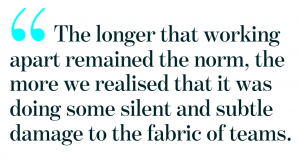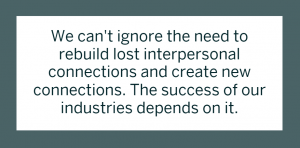Ahead of a fast-changing future, leaders need to bring their teams back together – with purpose, energy and through fostering a sense of belonging.
Through his work of helping organisations achieve this, HPC’s Head of Research, Justin Kinnear explores some of the ways in which leaders can personally reconnect with their team and how they are engaging HPC to instil wider team connectivity.
For more than two years, teams of all kinds have experienced change. For some, change meant having to work apart for prolonged periods, while for others it meant having to dramatically change work practices to avoid becoming sick. No team was untouched by the pandemic.
Having to suddenly work apart was initially perceived as a challenge, but for many it quickly became an opportunity. Suddenly, parents could be at home for breakfast or dinner with their families. Many people were now able to take daily exercise or reconnect with a hobby or friend. It is also worth noting that for many people, their experience of prolonged remote working was non-voluntary.
Silent and subtle damage

The longer that working apart remained the norm, the more we realised that it was doing some silent and subtle damage to the fabric of teams. While personal productivity for some was still high and holding, others were suffering from a lack of human connection. While this might be waved away as extraverted neediness, the genuine feelings of isolation, existential boredom, and stagnation were real for a great many workers.
At the team level, while technology has helped to keep us talking and connected, real connections between teams and beyond our teams have weakened dramatically. We know these connections are valuable because they keep us informed about the bigger picture and fuel serendipitous opportunities. We also know they are not replicable via video.

If we genuinely mean to embrace hybrid working – where some team members work mostly in the office while others work mostly at home – we can’t ignore the need to rebuild lost interpersonal connections and create new connections. The success of our industries depends on it.
Personal impact
The extended nature of the pandemic has given us time to develop a picture of how remote working, in particular, has affected team members in a range of settings. Work by Andrea Alexander and her colleagues at McKinsey noted that remote working had raised levels of burnout and anxiety, which was directly threatening long-term individual productivity. They also indicated that elevated anxiety was negatively affecting interpersonal relationships. Research by William Becker, Professor of Management at the Pamplin College of Business, highlights that many people working remotely have experienced loneliness and a lack of belonging. They suggest that organisations need to make a concerted effort to rebuild a sense of belonging and connection.
For many leaders, a fall in COVID cases in early 2022 felt like a chance to draw breath after a torrid and demanding period. Stepping back from countless check-in calls with individual staff, some leaders allowed a gap to open up in what was a very predictable drumbeat of conversation with their team members. For some team members, the sudden decreased availability of the leader felt like “ghosting”. This only served to add to the anxiety and feeling of disconnection triggered by prolonged remote working. In some teams, the only source of information about what was happening in the wider organisation was their manager. So, to suddenly feel this connection weaken added to an already elevated anxiety.

Connecting in person
Business Anthropologist Simon Roberts stresses the essential importance of connecting in person in a world of hybrid work. He suggests that while remote work confers many benefits, some things simply work better when we come together. In particular, he notes that the history of critical innovations features many examples of chance human encounters, a point echoed by Dr Christian Busch in his book “The Law of Serendipity”. Leaders have a pivotal responsibility to rebu ild connections, relationships, and trust by bringing their team members together in person now and then. They also play a huge role in creating and supporting chance encounters between teams and strangers that often lead to valuable opportunities and discoveries.
ild connections, relationships, and trust by bringing their team members together in person now and then. They also play a huge role in creating and supporting chance encounters between teams and strangers that often lead to valuable opportunities and discoveries.
How a leader can bring a team back together
If you’re a leader, your words and actions will shape the post-pandemic culture of your team. Start thinking about opportunities to bring your team together in person and consider some of these actions.
Share your vision and the next few steps. Everyone in the team knows the disruption caused by the pandemic. They all want and need to know what the new plan is, where you will lead them, and why that’s the destination. That vision might be some years away, so you should also share the first few steps that the team should take for the next 3-6 months. That will provide a balance between distant/intangible and near/tangible. It’s worth admitting that the vision and the steps to achieve it will almost certainly be adapted to accommodate issues and challenges that are encountered along the way.
Revisit psychological safety with your team. Working apart for a prolonged period has weakened relationships, trust, and our ability to ‘read’ each other when we interact in person. Rebuilding psychological safety will make it possible to get things out into the open, to hear one another, admit weaknesses and failings, and see that the leader needs everyone to play their part in making the team a success.
Don’t stop caring, keep checking in. It might feel like things are back to some form of normality, but the likelihood is that everything has changed and won’t be “going back to normal”. Throughout the pandemic, most leaders outdid themselves with the care shown for their team members. Regular check-in calls, flexible arrangements, and a desire to support each person according to their circumstances were hallmark behaviours of a golden period in people management. There’s no good reason to stop now. Keep checking in, keep showing you care, and keep supporting people as individuals.

Make time to meet in person with individuals. We live in an era of crisis right now, with problems almost everywhere. It can be difficult to know how individuals are coping with all the uncertainty and negativity. You may get a good sense of how they are doing on the phone or Zoom, but your greatest opportunities will come in face-to-face meetings with each team member. Make time to talk, or more critically, to listen. Find out what they think, how they feel, what they are worried about, and how you can help. Humans can’t suffer in silence indefinitely, and one of your key responsibilities is to know who needs your help.
Provide certainty, honesty, and fairness. If you are satisfied with how team members are performing, then tell them so. If you’re not satisfied, do the same. In uncertain times you will stand out as a beacon of certainty if you are willing to be honest and direct with your team. If an individual is not doing well, chances are they already know it and are waiting for you to confirm it. Don’t sugar-coat important messages, don’t shield people from the truth, and don’t avoid tackling problems. Be direct, be honest, and be fair with every member of the team.
Build them back up. It has been a tough two years for everyone, and it’s not surprising that people feel tired, disengaged, and low on motivation. Don’t forget to use coaching as a tool to encourage others to seize control of their challenges and empower themselves into action. Talk to team members about their development aims. Do they want to learn something new, or try their hand in a new area?
Re-evaluate what each person is now motivated by. Is it different to what motivated them before the pandemic? For many people, this is indeed the case. Remember to recognise people for great results and also for a great effort. As people start to reconnect, things won’t always be perfect but don’t miss a chance to recognise a good effort to do the right thing in the right way. Of course, one of the best ways to re-energise is to take a break, take some time off from work, and get some rest. Many sources suggest longer working days over the past 2 years. So, encourage your staff to stop, switch off, and come back rested and rejuvenated. You may need to lead by example here.
Commit to continuously improving practices. Nobody knows the right way to lead after a pandemic. Nobody has the winning formula for how to balance working in the office with working from home. We’re all learning as we go, and this will likely be the case for many more months. Teams that have adapted well to the uncertain conditions have adopted a try/review/tune approach to their working practices. This model allows the team to trial an improvement for a fixed period, review it at an agreed date, and then make further adjustments for a new fixed period. A team that can continuously learn and improve in times like these will surely be well prepared for whatever comes next. Encourage experimentation, learning, and the appropriate embrace of failure as we strive to do better and better as a team.

Reconnection events
Organisations are bringing their teams back together in different circumstances. In some cases, entire teams have not met since the pandemic began. In other cases, teams have not met in person for almost 8 years. Some teams have new members who have never had the chance to build an initial relationship. Organisations and leaders are paving the way to recreate a working model that is inclusive and rewarding.
As well as this, HPC is witnessing an organisational need to create more focused reconnection events – to welcome their team members back, rebuild existing relationships and create connections with new colleagues. We are helping organisations to figure out the best use of this “together time”, which gives leaders a chance to reconnect with team members, set out the vision for the team and decide which messages are most vital for employees to hear. We’re also leading team effectiveness sessions with teams that want to examine the practices that have emerged during the pandemic, tune them for the challenges ahead, and recommit to one another about ways of working and new standards. Finally, we’re also helping organisations through coaching teams and individuals, as they reflect on their recent experiences through the pandemic and explore the future paths that they want to follow.

If you’d like to discuss how HPC could help as you transition and reenergise your team, we’d be happy to share our experience, insights and approach with you at any stage. Please contact fiona.claridge@wearehpc.com
 Justin Kinnear is Head of Research at HPC. His passion for people development and his ability to inspire makes him a key member of HPC’s facilitation and coaching teams.
Justin Kinnear is Head of Research at HPC. His passion for people development and his ability to inspire makes him a key member of HPC’s facilitation and coaching teams.
As well as his extensive research and facilitation experience, he was formerly Head of L&D at IBM and Britvic.
His work with HPC focuses on the development of a high performance culture for our clients with a particular emphasis on accountability and feedback.